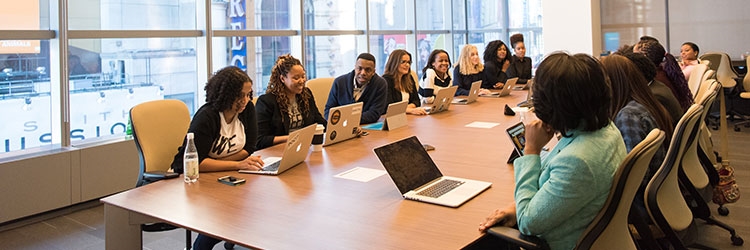Did you know by 2022, more than 75 percent of large enterprises will include diversity and inclusion enablement criteria in the selection process for Human Capital Management (HCM) technologies? Diversity and inclusion is quickly moving to the top of the list of priorities for HR professionals at businesses of all sizes. But how can HR professionals keep up with the times on this important topic? True diversity and inclusion takes more than a training video about being polite to coworkers. Here’s what you need to know to get it right.
What is diversity and inclusion?
Before you begin to develop a diversity and inclusion strategy, it’s helpful to take a moment to understand what you’re committing to. Ferris State University offers excellent definitions to use as a touchstone for this important work:
Diversity is the full range of human experience. It can refer to race, class, gender identity, sexual orientation, political beliefs, religion, culture, and more.
Inclusion is involvement and empowerment. When people are included, their worth is recognized, and respected.
It can be helpful to think of diversity as an adjective and inclusion as a verb. “Diversity” describes the company you wish to create, in which a wide range of identities are reflected in your workforce. “Inclusion” is what you do to make sure that these different people feel seen and valued. Diversity without inclusion is meaningless, but true diversity and inclusion can be a powerful force to drive your company forward.
Why diversity and inclusion matters
McKinsey and Company found that companies in the top quartile for gender inclusivity were 21 percent more like to experience above-average profitability. For ethnic diversity, this number jumped to 33 percent. Furthermore, Gartner research reveals that inclusive teams unlock diversity benefits by improving team performance by up to 30 percent in high-diversity environments. Put another way: Companies committed to diversity and inclusion are more successful.
Strong diversity and inclusion practices also help businesses to recruit talented employees. Research by PwC shows that over 80 percent of millennial workers name a company’s diversity and inclusion policy as an important factor in considering a job offer.
Once hired, diverse teams perform better. They’re able to solve problems faster and are much more likely to make good decisions. Inclusive companies are also 1.7 times more likely to be leaders in innovation, presumably because diverse teams can draw on a much broader background of experience as they work together.
Finally, employees at diverse companies report higher levels of engagement. Engaged employees provide better customer service and stay on the job longer, helping businesses avoid costly turnover, and low morale.

Diversity and inclusion best practices
Diversity and inclusion isn’t something that you can make happen overnight, but there are tried-and-true ways to make sure your diversity and inclusion initiatives succeed. From the C-Suite to new hires, these best practices should guide your thinking about diversity and inclusion:
Start from the top
That influential McKinsey report recommends a “commit and cascade” approach to improving diversity in the workplace. It all starts with a compelling vision from the CEO that is clearly articulated to the entire company. Next, upper management needs to walk the walk, diversifying its own ranks and modeling inclusive behavior to all employees. Social information processing theory posits that this type of modeling from authentic leaders is an effective way to change company culture.
Develop a plan
Diversity and inclusion doesn’t happen naturally, so it’s crucial for businesses to develop an action plan for improvement. Designate a top executive to take the lead and organize a committee to begin this important work. Below are some priorities to consider in your plan:
- Fair treatment for all
- Equal pay, benefits, and working conditions
- Transparent compensation practices
- Equal opportunity for advancement
- Collaborative conflict resolution
- Diversity education and training
- Employee networks
- Community outreach
- Defined behaviors in the workplace
- Recruitment initiatives
- Workplace accessibility initiatives
Gather feedback and act
For any diversity and inclusion initiative to work, it needs to be responsive to the needs of employees. The best way to understand those needs is to gather frequent employee feedback about the state of your company’s culture. An initial survey about the current state of diversity and inclusion in your company will give you a baseline for making improvements that will have the biggest impact. Don’t limit employee surveys to become an annual event. Gather feedback on a frequent basis in order to track the success of new initiatives, keep an eye on engagement and morale, and act in real-time to address concerns.
Pro tip: Be sure to include a place for employees to offer their own suggestions for improving diversity in the workplace — you’ll get creative ideas you might otherwise never have thought of.
Grapple with unconscious bias
Unconscious bias is difficult to overcome, but it can inform everything from hiring decisions to lunch room conversation. Training in this area can be eye-opening, and it’s especially important for anyone involved in the hiring process to examine their language, interview questions, and rubric for making hiring and promotion decisions to ensure that you aren’t unconsciously ruling out candidates for “fit” for the wrong reasons.
Recognize employee efforts
Employee recognition programs are a great way to emphasize inclusion in the workplace. Everyone wants to feel valued, and a robust recognition program gives everyone the opportunity to feel seen and appreciated. According to an Achievers report, 91 percent of employees said they “strongly” or “somewhat” agreed recognizing their colleagues makes them feel happier at work. Furthermore, organizations that give frequent recognition also are 34 percent more likely to see increased employee engagement. Encourage employees to practice social recognition to highlight the their teammate’s contributions and create a supportive environment. In addition to helping people feel like they belong, recognition and rewards can also be used to “teach” the culture you want to see. For example, when someone is recognized and rewarded for teamwork, a positive attitude, or willingness to help, those values are highlighted for all to aspire towards.

Final thoughts
Diversity and inclusion is a movement that has the power to transform your company into one that’s more engaging and profitable – as well as one that talented people are clamoring to work for. To learn more about how to build an engaging workplace culture, access our webinar recording, “The Evolution of Connection and Need for Belonging.”
Business & Finance Articles on Business 2 Community
(56)








